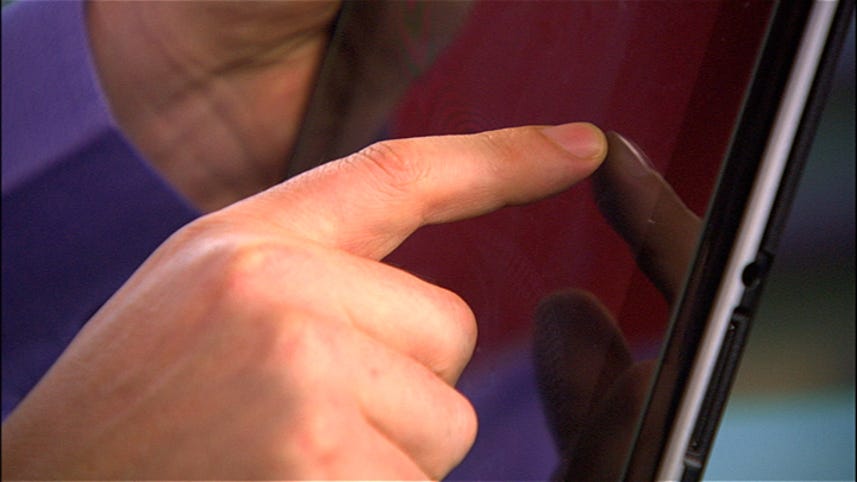
Speaker 1: Hi.
This is Rafe Needleman from CNET.
I'm here with Dave Rice of Senseg, looking at a prototype technology that you may be seeing on your smart phone and tablets in about 12 months.
What we're talking about today is a tablet that touches you back.
Dave, what we are here...
As I row my fingers over this demo, this is smooth.
This is still smooth like glass or plastic and if I do this, I can feel these little balls are rolling my finger over.
Speaker 2: You can feel it.
Speaker 1: What's happening here?
Speaker 2: What Senseg does is it uses an electrostatic field to turn touchscreens into feel screens.
Speaker 1: Different textures, gravel, packing material.
This is sand paper.
Feels weird.
Speaker 2: Certainly game designers can create hidden objects that you can only find by feel.
Speaker 1: And when you feel friction which I'm feeling right there, you let go and see if you found a hidden treasure.
I could also think it's useful in pre-automotive applications where you really want to keep your eyes off the screen as much as possible.
Speaker 2: Certainly being able to help...
Help users orient themselves on the screen and understand that they've correctly executed an action is something that, that we're geared toward and it's a great application of the technology.
Speaker 1: Now you said briefly this is electrostatic, explain to us technologically what is happening here.
Are you vibrating the screen or putting little ridges up or what?
Speaker 2: We actually creating attractive force between the finger and the screen so...
So we do modulate friction somewhat that that gives your sensory perception of physical edges, contours and textures.
So that gives the application designers an incredible range of opportunity to engage users and provide more dimension to their applications.
Speaker 1: So this is actually not moving.
It's changing the friction between the user and the screen itself.
Speaker 2: That's right.
There's no mechanical movement at all.
So that's a big difference between what Senseg does and what traditional haptics do.
Speaker 1: All right.
Now, I don't imagine this is a consumer retrofit.
This is something that you want to get baked into tablets from Apple, Android tablets.
What the business of this and how our consumers are gonna get this technology?
Speaker 2: Certainly.
This does need to be built into devices by manufacturers into touch pads, into tablets, into large screen displays.
Because of the nature our technology, there's really no limit to the size of a device that it can be deployed on.
But the manufacturer needs to do that and then we'll have a software programming interfaces that application developers used to add these types of effects to their products.
Speaker 1: Not to jinx it but best guess, when do you think that we will see this in a consumer product?
Speaker 2: Oh.
We're certainly optimistic that we'll have something in the next year.
That might extend the 24 months but we are moving quickly with some of our conversations.
Speaker 1: All right.
So the company is Senseg.
Mr. Dave Rice, Thank you very much.
Speaker 2: Thanks, Rafe.
I appreciate it.